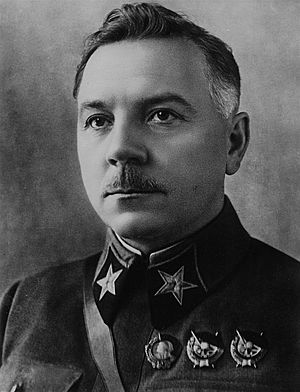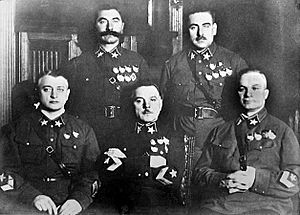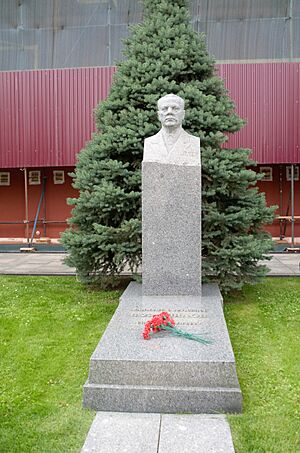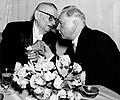Kliment Voroshilov facts for kids
Quick facts for kids
Kliment Voroshilov
|
|
|---|---|

Voroshilov in 1937
|
|
| Chairman of the Presidium of the Supreme Soviet |
|
| In office 15 March 1953 – 7 May 1960 |
|
| General Secretary | Nikita Khrushchev |
| Preceded by | Nikolay Shvernik |
| Succeeded by | Leonid Brezhnev |
| People's Commissar for Defense of the Soviet Union | |
| In office 31 October 1925 – 7 May 1940 |
|
| Premier | Alexey Rykov Vyacheslav Molotov |
| Preceded by | Mikhail Frunze |
| Succeeded by | Semyon Timoshenko |
| Full member of the 14th, 15th, 16th, 17th, 18th, 19th, and 20th–21st Presidiums | |
| In office 1 January 1926 – 16 July 1960 |
|
| Personal details | |
| Born |
Kliment Yefremovich Voroshilov
4 February 1881 Verkhnyeye, Bakhmut, Yekaterinoslav Governorate, Russian Empire |
| Died | 2 December 1969 (aged 88) Moscow, Russian SFSR, Soviet Union |
| Resting place | Kremlin Wall Necropolis, Moscow |
| Nationality | Soviet |
| Political party | RSDLP (Bolsheviks) (1903–1918) Russian Communist Party (1918–1961, 1966–1969) |
| Spouse | Ekaterina Davidovna |
| Awards | Hero of the Soviet Union (twice) Hero of Socialist Labour Order of Lenin (eight times) Order of the Red Banner (six times) Order of Suvorov |
| Military service | |
| Allegiance | |
| Branch/service | Soviet Army |
| Years of service | 1917–1969 |
| Rank | Marshal of the Soviet Union |
| Commands | North Caucasus Military District Moscow Military District Leningrad Front |
| Battles/wars | Russian Civil War Polish–Soviet War Winter War World War II |
Kliment Yefremovich Voroshilov (born February 4, 1881 – died December 2, 1969) was an important Soviet military leader and politician. He was often called Klim Voroshilov. He was one of the first five people to be named a Marshal of the Soviet Union, which was the highest military rank in the Soviet Union.
Voroshilov also served as the Chairman of the Presidium of the Supreme Soviet. This role made him the official head of state for the Soviet Union from 1953 to 1960. He played a key part in the Soviet government during the time of Joseph Stalin.
Contents
Early Life and Beginnings
Kliment Voroshilov was born in a small village called Verkhnyeye. This area is now part of Ukraine. His family worked on the railway. When he was young, he became good friends with Semyon Ryzhkov, who later became an important political figure.
Joining the Revolution
In 1903, Voroshilov joined the Bolshevik group. This group was part of the Russian Social Democratic Labour Party. After the Russian Revolution of 1917, he became a key member of the Ukrainian government. He was in charge of internal affairs.
During the Russian Civil War, Voroshilov became close friends with Joseph Stalin. They worked together during the 1918 defense of Tsaritsyn. This city was later renamed Stalingrad and is now Volgograd. Voroshilov was a commander on the Southern Front during the Civil War. He also fought in the Polish–Soviet War.
Between the World Wars
Voroshilov was a member of the Central Committee of the Communist Party of the Soviet Union from 1921 to 1961. In 1925, he became the People's Commissar for Military and Navy Affairs. This meant he was in charge of the military and navy. He held this important position until 1934.
One of his main achievements was moving important Soviet war factories. He moved them to areas east of the Ural Mountains. This helped the Soviet Union keep its ability to make weapons safe. In 1926, he became a full member of the Politburo. This was a very powerful group in the Communist Party.
In 1935, Voroshilov was named a Marshal of the Soviet Union. During the 1930s, a difficult period known as the Great Purge took place. Voroshilov was involved in some of the tough decisions made during this time. He helped to modernize the Red Army. He believed that the army should rely less on cavalry and more on modern weapons like tanks.

World War II and Later Roles
Voroshilov led Soviet troops during the Winter War against Finland from 1939 to 1940. The Soviet army faced many challenges during this conflict. Because of these difficulties, he was replaced as Defense Commissar by Semyon Timoshenko.
When Germany invaded the Soviet Union in June 1941, Voroshilov was called back to duty. He became a member of the USSR State Defense Committee. He commanded the Leningrad Front in September 1941. He showed personal bravery during the Siege of Leningrad. He even led a counter-attack against German tanks with just a pistol. However, he was unable to stop the Germans from surrounding Leningrad. He was then replaced by Georgy Zhukov.
After World War II, Voroshilov helped set up a socialist government in Hungary.
Leadership After Stalin
In 1952, Voroshilov became a member of the Presidium of the Communist Party. After Stalin died in March 1953, big changes happened in the Soviet leadership. On March 15, 1953, Voroshilov became the Chairman of the Presidium of the Supreme Soviet. This made him the official head of state.
One of his jobs was to review appeals from people sentenced to death. He often tried to be fair and showed kindness, especially to those who seemed sorry for their actions. He was more strict with people who committed political crimes.
Later Years and Retirement
As Nikita Khrushchev gained more power, Voroshilov's influence began to lessen. In May 1960, he officially retired from his role as head of state. Leonid Brezhnev took over his position. Voroshilov was also removed from the Party Presidium in July 1960.
However, after Khrushchev lost power, Brezhnev brought Voroshilov back into a political role. He was re-elected to the Central Committee in 1966. In 1968, he received his second Hero of the Soviet Union medal.
Death

Kliment Voroshilov passed away on December 2, 1969, at the age of 88. He was buried in the Kremlin Wall Necropolis in Moscow. This is a special burial place for important Soviet figures.
Personal Life

Voroshilov was married to Ekaterina Voroshilova. They met while both were living in exile. They adopted a four-year-old orphan boy named Petya. They also adopted the children of Mikhail Frunze after his death.
People who knew Voroshilov described him as a good speaker. He was very loyal to the Communist Party and to Stalin. However, his loyalty was sometimes questioned by others.
Honours and Awards
Many things were named after Kliment Voroshilov. The Kliment Voroshilov (KV) series of tanks, used in World War II, was named after him. Two towns were also named in his honour: Voroshilovgrad in Ukraine (now Luhansk) and Voroshilov in the Soviet Far East (now Ussuriysk).
He received many awards for his service, including:
- Hero of the Soviet Union (twice)
- Hero of Socialist Labour
- Order of Lenin (eight times)
- Order of the Red Banner (six times)
- Order of Suvorov, 1st class
He also received awards from other countries, such as Mongolia, Finland, and Turkey.
Images for kids
-
The red banner from the Paris Commune, brought to Moscow by French communists. On the photo: Kliment Voroshilov first on the right, Grigory Zinoviev third from the right, Avel Enukidze fourth from the right and Nikolay Antipov fifth from the right. 1924
-
Voroshilov (right) with J.K. Paasikivi in Moscow
See also
 In Spanish: Kliment Voroshílov para niños
In Spanish: Kliment Voroshílov para niños
- Russian Civil War
- World War II
- Joseph Stalin
- Nikita Khrushchev
- Marshal of the Soviet Union




